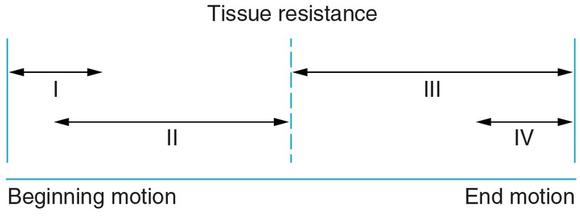Clinical application of joint thrusts and nonthrusts
This is an excerpt from Orthopedic Joint Mobilization and Manipulation With Web Study Guide by Robert C Manske,BJ Lehecka,Michael P Reiman,Janice K Loudon.
Parameters applied to joint thrusts and nonthrusts vary widely. The force, frequency, and amplitude of techniques vary depending on client, clinician, and joint factors. For example, select clients may tolerate only small forces and amplitudes of nonthrusts over a short duration. If significant pain is present, nonthrusts should be applied using relatively small amplitudes and small forces. Maitland described four grades of nonthrust techniques (figure 2.1) (Maitland, 2005). Grades I and II are small and large amplitude nonthrusts, respectively, that do not reach the end of a joint's available arthrokinematic motion. These grades are generally for painful joints or apprehensive clients. Grades III and IV are large and small amplitude nonthrusts, respectively, that reach the end of a joint's available motion. These grades are generally used to increase arthrokinematic motion.

Maitland grades of movement.
Recommendations for the force, frequency, and amplitude of nonthrust techniques also vary depending on the joint being treated. For example, in the lumbar spine, evidence shows the average force for grade IV nonthrusts ranges from 90 N to 240 N (Snodgrass, 2006). In the knee, grade IV nonthrusts appear to be between 30 N and 78 N (Pentelka, Hebron, Shapleski, and Goldshtein, 2012). In larger joints, such as the knee and hip, clinicians should be able to appreciate arthrokinematic motion visually in addition to feeling the joint translation with their hands. This observation is more challenging at smaller joints such as the cervical spine.
Concerning the frequency of nonthrusts, one estimate is that clinicians apply oscillations at a rate of 1 to 1.5 per second (Snodgrass, 2006). One recommendation has been made for at least 4 sets of 60 seconds of oscillations to induce the analgesia at the lumbar spine (Pentelka et al., 2012). However, clinicians should modify their frequency and duration of manual therapy techniques to fit client needs.
Learn more about Orthopedic Joint Mobilization and Manipulation With Web Study Guide.
More Excerpts From Orthopedic Joint Mobilization and Manipulation With Web Study GuideSHOP

Get the latest insights with regular newsletters, plus periodic product information and special insider offers.
JOIN NOW


